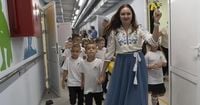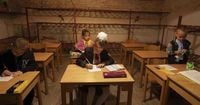As the school bell rang across Ukraine on September 1, 2025, it marked not just the start of a new academic year, but also the latest chapter in the country’s remarkable efforts to educate its children amid the ongoing Russian invasion. For thousands of Ukrainian pupils, the return to school meant descending into newly built or hastily adapted underground classrooms—spaces designed to shield young learners from the ever-present threat of bombs and drones.
In Bobryk, a small village nestled in the northern Sumy region close to the Russian border, the first day of school unfolded in a basement transformed into a haven for learning. According to the Associated Press, the school’s principal, Oleksii Korenivskyi, spoke with determination about the mission ahead: “We must do everything so this generation is not lost. Time is the only thing you cannot make up. This is our future, and we must give it everything we have.”
Bobryk’s school, once housed in a stately early 20th-century building, moved its entire operation underground two years ago. The reason was simple, but harrowing: air raid alerts sometimes stretched to 20 hours, making conventional classes impossible. The only option was to seek shelter and, while hiding from possible explosions, keep studying. The new underground school occupies the basement of an administrative building, never intended for education. Classrooms are carved out of narrow corridors, some separated only by heavy plastic sheets. There are no windows or doors, just the hum of ventilation and the soft glow of electric lights—recent additions that have helped transform the once damp and dark space into a functional, if unconventional, school.
On the first day, children arrived in traditional embroidered shirts, known as vyshyvanka, and presented their teachers with fresh flowers—a gesture that felt both hopeful and poignant. During the opening lesson, a teacher pointed to a map showing Ukraine as a whole, with no marks for occupied territories. She explained, “Our region is next to Russia. That’s why it’s so hard, why they bomb us so often—because we are close to this difficult neighbor.”
Bobryk’s school now serves just over 100 students, with classes averaging around 10 children each. This year, only seven first-graders filled their small classroom. Since the full-scale invasion began in February 2022, about 10% of the student body has left, and more departures are expected. Among those preparing to leave is 15-year-old Vlada Mykhailyk, who, along with her 11-year-old brother, will soon move to Austria because their mother feels the risks have become too great. “We live well, but sometimes it’s sad. We often hear Shaheds [drones] and explosions,” Vlada shared with the Associated Press. Still, she said, “If you have to choose between online or in the basement, the basement is better.” The pull of friendship and the desire for normalcy are strong—Vlada confessed she would rather finish school with her friends than leave.
For those who remain, the rhythms of school life continue, albeit in two shifts with shortened breaks to accommodate the cramped quarters. The original schoolhouse sits empty, its spacious classrooms waiting for safer days. Seven-year-old Eva Tui, starting her third year underground, remembers her old classroom just 400 meters away as warmer and cozier. “We’re here because it’s wartime and there are a lot of sirens,” Eva explained. Her wish for the year is simple: “To go back to the classroom. It feels more like home.” But her greatest hope is even simpler: “For the war to end.”
Similar scenes played out in Kharkiv, Ukraine’s second-largest city, where the start of the school year brought a wave of cautious optimism and innovation. According to Gwara Media, three new underground schools opened their doors on September 1, including one in the Saltivskyi district—the closest to the Russian border and a frequent target of attacks since 2022. Local authorities and educators have spearheaded a massive effort to keep students safe while preserving the social and developmental benefits of in-person learning.
Kharkiv’s mayor, Ihor Terekhov, described the new school in Saltivskyi as “one of the closest schools to the border with Russia. You can see how deep it was built. Depth is a very important factor. The school is large and can contain up to 1,500 pupils.” The facility is equipped with 16 classrooms, an elevator, and provisions for 20 students with special educational needs and disabilities. Students from grades 1 to 11 will study in a mixed format, combining online and offline lessons—a nod to both the realities of war and the need for flexibility.
For many teachers, the return to face-to-face learning—even underground—was a cause for celebration. Yuliia Holozubova, a fifth-grade teacher with two decades of experience, called the move “an exciting and joyful event for everyone.” She emphasized the importance of students being able to see each other in person again, after so many months of remote learning. Viktoriia Zhuravel, a primary school teacher for 32 years, echoed this sentiment, highlighting her hopes for renewed social and communication skills among her pupils.
The scale of Kharkiv’s response is striking. Mayor Terekhov noted that seven underground schools have been constructed—six of them in converted subway stations—each designed for 1,200 students in two shifts. This allows an additional 3,600 children to receive in-person education, with 17,000 pupils in the city now able to attend classes offline. And the effort continues: three more underground schools are under construction and are expected to open by January 1, 2026.
Saltivskyi district, where the new school is located, has suffered significant damage since the beginning of the full-scale invasion. The need for secure, resilient educational spaces has never been more acute. As Kateryna, the mother of a first grader, told Gwara Media, her son “has been waiting for this day for a long time. He wants to study and get to know his classmates, very happy and excited to start studying at the school.”
Across Ukraine, the drive to adapt and persevere is evident in every makeshift classroom, every teacher’s smile, and every child’s hopeful glance at the future. Whether in Bobryk’s narrow basement corridors or Kharkiv’s purpose-built subterranean schools, the message is clear: even in the darkest times, learning endures. The underground classrooms stand as a testament to the resilience of a nation and the unbreakable spirit of its youngest generation, determined to keep growing, dreaming, and learning—no matter what shadows loom overhead.



